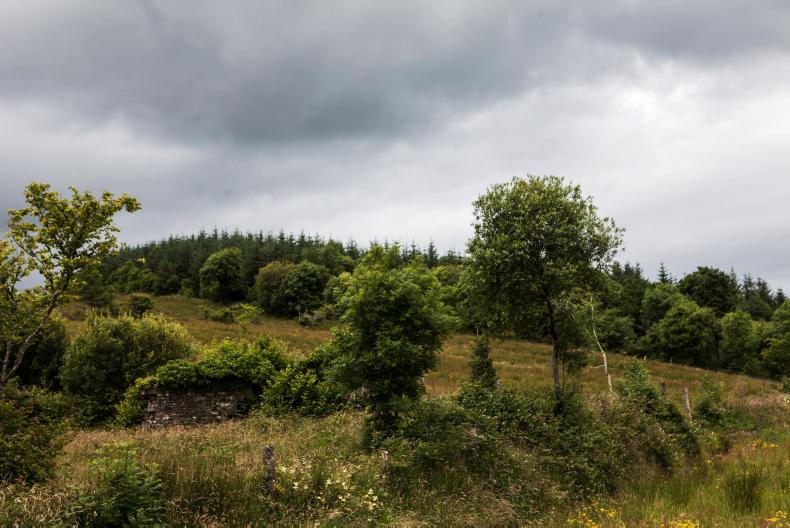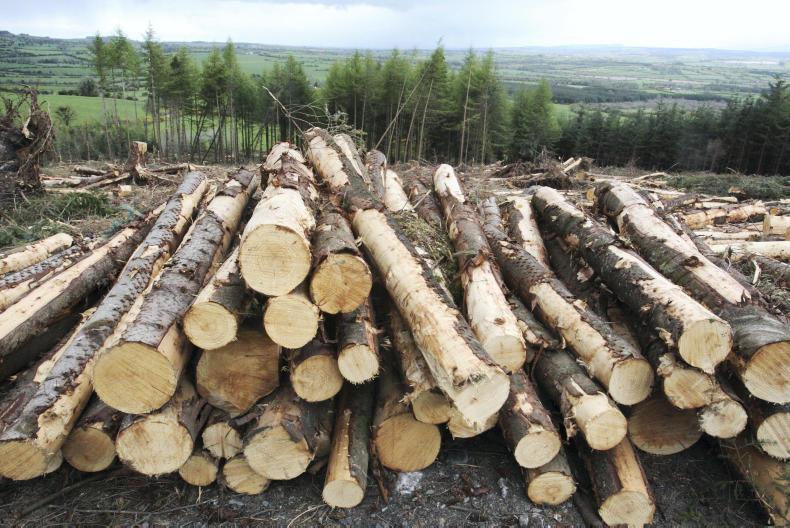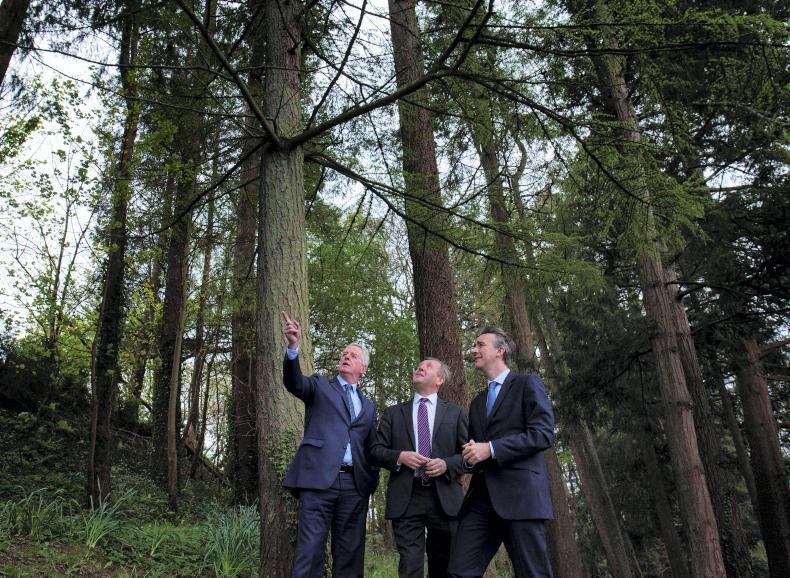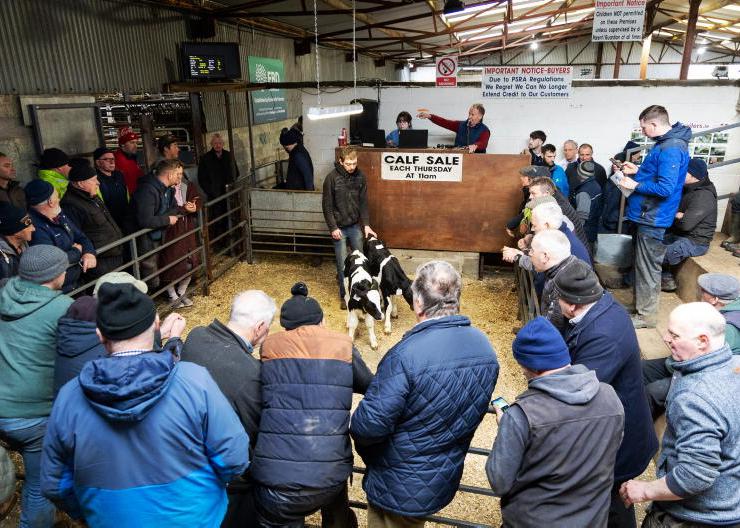Timber prices have remained steady during the first six months of the year.
Medium to large sawlog prices are down by 5% compared to the same period in 2015, but small log prices – from first thinnings – are marginally up.
Prices are made available for each quarter by Coillte and Wood Price Quarterly (WPQ). WPQ provides price data issued by University College Dublin in collaboration with the Irish Timber Growers Association (ITGA) for the private sector.
The UK is an important export market for panel board material, while the sawmilling sector exports virtually all sawn timber to England, so the performance of sterling has a major impact on timber prices from finished product back to the forest.
Despite concerns that lower log prices are inevitable if sterling remains weak, growers shouldn’t panic. Forestry is not a seasonal crop so there is a much longer timeframe to make harvesting decisions compared to agriculture.
The timing of harvesting and selling depends on the production cycle of the crop which can be divided into the following three stages:
First thinningSecond and subsequent thinningClearfellFirst thinning
Depending on crop yield, location and species, revenue can vary from €450 to €550/ha based on current prices for small logs (up to .124m3) which range from €11.80 to €14.00 (Table 1).
Delaying first thinning and holding out for a better price is false economy. The advice is to thin on time, but shop around for prices.
Prices remain strong for small logs partly because the influence of sterling fluctuations is not as strong especially in markets such as wood energy.
Subsequent thinning
After the first thinning is complete the second and subsequent thinnings can take place over three to five year cycles depending on yield: the higher the yield the shorter the thinning cycle.
If an owner wishes to have a regular income he/she should thin regularly. Prices for medium logs are still good. If crops are thinned on time, they can provide an income up to €2,400 at third thinning (Table 1).
Clearfell
The clearfell harvest is the major payday for forest owners as it provides an income to cover past investment and reforestation costs.
While the advice is to thin even if prices are low, forest owners with crops at the clearfell stage have a number of options. They can delay clearfelling until a satisfactory price is achieved as the crop will continue to increase in volume and value.
Also, while waiting for the price to increase, the owner can carry out a further thinning. For example a 30-year old high yielding Sitka spruce crop can provide revenue of up to €3,000/ha from a fourth thinning (Table 1).
It should be remembered that a yield class (YC) 24 (m3/ha/annum) crop is putting on an annual increment of over 34m3/ha at age 30 so delaying clearfell might make good economic sense regardless of timber prices. However, the plantation owner has to take into account the vulnerability of the crop to windblow, especially on exposed sites.
 Whether thinning or clearfelling “the importance of having a clear agreement on a sale and clear sale specifications are more important now than ever,” according to Donal Whelan, technical director, ITGA (pictured).
Whether thinning or clearfelling “the importance of having a clear agreement on a sale and clear sale specifications are more important now than ever,” according to Donal Whelan, technical director, ITGA (pictured).
“A model timber sales dispatch system has been developed by the ITGA and is now widely used in the private sector,” he said.
“ Also, ITGA has produced a ‘Template Master Tree Sales Agreement’ to assist growers adapt their sales to their own needs.” Both documents are available on www.itga.ie.
Outlook
Despite the fall in sterling against the euro – £1.40 to £1.15 from 20 November 2015 to 15 August this year – log prices have held up remarkably well. The next set of quarterly data will not be available until October, but is likely to reflect a number of recent trends including the continued weak performance of sterling and market uncertainty following Britain’s decision to leave the EU.
Read more
Translating national forestry activity to local wealth and job creation
Timber prices have remained steady during the first six months of the year.
Medium to large sawlog prices are down by 5% compared to the same period in 2015, but small log prices – from first thinnings – are marginally up.
Prices are made available for each quarter by Coillte and Wood Price Quarterly (WPQ). WPQ provides price data issued by University College Dublin in collaboration with the Irish Timber Growers Association (ITGA) for the private sector.
The UK is an important export market for panel board material, while the sawmilling sector exports virtually all sawn timber to England, so the performance of sterling has a major impact on timber prices from finished product back to the forest.
Despite concerns that lower log prices are inevitable if sterling remains weak, growers shouldn’t panic. Forestry is not a seasonal crop so there is a much longer timeframe to make harvesting decisions compared to agriculture.
The timing of harvesting and selling depends on the production cycle of the crop which can be divided into the following three stages:
First thinningSecond and subsequent thinningClearfellFirst thinning
Depending on crop yield, location and species, revenue can vary from €450 to €550/ha based on current prices for small logs (up to .124m3) which range from €11.80 to €14.00 (Table 1).
Delaying first thinning and holding out for a better price is false economy. The advice is to thin on time, but shop around for prices.
Prices remain strong for small logs partly because the influence of sterling fluctuations is not as strong especially in markets such as wood energy.
Subsequent thinning
After the first thinning is complete the second and subsequent thinnings can take place over three to five year cycles depending on yield: the higher the yield the shorter the thinning cycle.
If an owner wishes to have a regular income he/she should thin regularly. Prices for medium logs are still good. If crops are thinned on time, they can provide an income up to €2,400 at third thinning (Table 1).
Clearfell
The clearfell harvest is the major payday for forest owners as it provides an income to cover past investment and reforestation costs.
While the advice is to thin even if prices are low, forest owners with crops at the clearfell stage have a number of options. They can delay clearfelling until a satisfactory price is achieved as the crop will continue to increase in volume and value.
Also, while waiting for the price to increase, the owner can carry out a further thinning. For example a 30-year old high yielding Sitka spruce crop can provide revenue of up to €3,000/ha from a fourth thinning (Table 1).
It should be remembered that a yield class (YC) 24 (m3/ha/annum) crop is putting on an annual increment of over 34m3/ha at age 30 so delaying clearfell might make good economic sense regardless of timber prices. However, the plantation owner has to take into account the vulnerability of the crop to windblow, especially on exposed sites.
 Whether thinning or clearfelling “the importance of having a clear agreement on a sale and clear sale specifications are more important now than ever,” according to Donal Whelan, technical director, ITGA (pictured).
Whether thinning or clearfelling “the importance of having a clear agreement on a sale and clear sale specifications are more important now than ever,” according to Donal Whelan, technical director, ITGA (pictured).
“A model timber sales dispatch system has been developed by the ITGA and is now widely used in the private sector,” he said.
“ Also, ITGA has produced a ‘Template Master Tree Sales Agreement’ to assist growers adapt their sales to their own needs.” Both documents are available on www.itga.ie.
Outlook
Despite the fall in sterling against the euro – £1.40 to £1.15 from 20 November 2015 to 15 August this year – log prices have held up remarkably well. The next set of quarterly data will not be available until October, but is likely to reflect a number of recent trends including the continued weak performance of sterling and market uncertainty following Britain’s decision to leave the EU.
Read more
Translating national forestry activity to local wealth and job creation
 Whether thinning or clearfelling “the importance of having a clear agreement on a sale and clear sale specifications are more important now than ever,” according to Donal Whelan, technical director, ITGA (pictured).
Whether thinning or clearfelling “the importance of having a clear agreement on a sale and clear sale specifications are more important now than ever,” according to Donal Whelan, technical director, ITGA (pictured).










SHARING OPTIONS